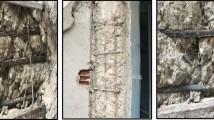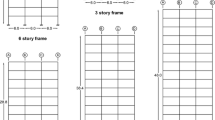Abstract
Previous quasi-static cyclic tests of shear walls, which routinely used an incremental lateral displacement test protocol with a constant axial load, failed to reflect the character of moment-shear force interaction of prototype buildings. To study the effect of the moment-shear force interaction on the seismic performance of shear walls, three identical 2-story shear wall specimens with different loading patterns were constructed at 1/2 scale, to represent the lower portion of an 11-story high-rise building, and were tested under reversed cyclic loads. The axial force, shear force and bending moment were simultaneously applied to simulate the effects of gravity loads and earthquake excitations on the prototype. The axial force and bending moment delivered from the upper structure were applied to the top of the specimens by two vertical actuators, and the shear force was applied to the specimens by two horizontal actuators. A mixed force-displacement control test program was adopted to ensure that the bending moment and the lateral shear were increased proportionally. The experimental results show that the moment-shear force interaction had a significant effect on the failure pattern, hysteretic characteristics, ductility and energy dissipation of the specimens. It is recommended that moment-shear force interaction should be considered in the loading condition of RC shear wall substructures cyclic tests.
Similar content being viewed by others
References
Alarcon C, Hube MA and De ILJC (2014), “Effect of Axial Loads in the Seismic Behavior of Reinforced Concrete Walls with Unconfined Wall Boundaries,” Engineering Structures, 73: 13–23.
Arteta C, To D and Moehle J (2014), “Experimental Response of Boundary Elements of Code-Compliant Reinforced Concrete Shear Walls,” Proceedings of the 10th US national conference on earthquake engineering, 864: 21–25.
Bekő A, Rosko P, Wenzel H, Pegon P, Markovic D and Molina FJ (2015), “RC Shear Walls: Full-Scale Cyclic Test, Insights and Derived Analytical Model,” Engineering Structures, 102: 120–131.
CCDCS (2010), Chinese Code for Design of Concrete Structures, China Ministry of Construction, China Architecture and Building Press: Beijing, China.
Cheng MY, Fikri R, and Chen CC (2015), “Experimental Study of Reinforced Concrete and Hybrid Coupled Shear Wall Systems,” Engineering Structures, 82: 214–225.
CMMTT (2010), Code for Metallic Materials Tensile Testing: Part I: Method of Test at Room Temperature (GB228.1-2010), China Ministry of Construction, China Architecture and Building Press: Beijing, China.
CSDC (2010), Code for Seismic Design of Buildings (GB50011-2010), China Ministry of Construction, China Architecture and Building Press: Beijing, China.
Farrar CR and Baker WE (2010), “Experimental Assessment of Low-Aspect-Ratio, Reinforced Concrete Shear Wall Stiffness,” Earthquake Engineering & Structural Dynamics, 22(5): 373–387.
Ghannoum W, Saouma V, Haussmann G, Polkinghorne K and Kang DH (2012), “Experimental Investigations of Loading Rate Effects in Reinforced Concrete Columns,” Journal of Structural Engineering, 138(8): 1032–1041.
Haselton CB, Liel AB and Deierlein GG (2009), “Simulation Structural Collapse Due to Earthquakes: Model Idealization, Model Calibration, and Numerical Solution Algorithms,” Computational Methods in Structural Dynamics and Earthquake Engineering (COMPDYN), Rhodes, Greece.
Hube MA, Marihuén A, De ILJC and Stojadinovic B (2014), “Seismic Behavior of Slender Reinforced Concrete Walls,” Engineering Structures, 80: 377–388.
Ji Xiaodong, Liu Dan and Qian Jiaru (2017), “Improved Design of Special Boundary Elements for T-Shaped Reinforced Concrete Walls” Earthquake Engineering and Engineering Vibration, 16(1): 83–95. https://doi.org/10.1007/s11803-017-0370-4.
Jünemann R, De ILJC, Hube MA, Cifuentes LA and Kausel E (2015), “A Statistical Analysis of Reinforced Concrete Wall Buildings Damaged During the 2010 Chile Earthquake,” Engineering Structures, 82: 168–185.
Jünemann R, De ILJC, Hube MA, Vásquez JA and Chacón MF (2016), “Study of the Damage of Reinforced Concrete Shear Walls During the 2010 Chile Earthquake,” Earthquake Engineering & Structural Dynamics, 45(10): 1621–1641.
Jiang HJ, Wang B and Lu XL (2013), “Experimental Study on Damage Behavior of Reinforced Concrete Shear Walls Subjected to Cyclic Loads,” Journal of Earthquake Engineering, 17(7): 958–971.
Kaltakci MY, Ozturk M and Arslan MH (2010), “An Experimental Investigation for External RC Shear Wall Applications,” Natural Hazards & Earth System Sciences, 10(9): 1941–1950.
Kam WY, Pampanin S and Elwood K (2011), “Seismic Performance of Reinforced Concrete Buildings in the 22 February Christchurch (Lyttelton) Earthquake,” Bulletin of the New Zealand National Society for Earthquake Engineering, 44(4): 239–278.
Karamlou A and Kabir MZ (2012), “Experimental Study of L-Shaped Slender R_ICF Shear Walls under Cyclic Lateral Loading,” Engineering Structures, 36: 134–146.
Lequesne RD, Parra-Montesinos GJ and Wight JK (2016), “Seismic Response of Fiber-Reinforced Concrete Coupled Walls,” ACI Structural Journal, 113(3): 435–445.
Liang X, Dong Z, Wang Y and Deng M (2009), “Damage to Tall Buildings in Areas with Large Epicentral Distance during M8.0 Wenchuan Earthquake,” Journal of Earthquake Engineering & Engineering Vibration, 29(1): 24–31. (in Chinese)
Lu Xilin, Yang Boya and Zhao Bin (2018), “Shake-Table Testing of a Self-Centering Precast Reinforced Concrete Frame with Shear Walls,” Earthquake Engineering and Engineering Vibration, 17(2): 221–233. https://doi.org/10.1007/s11803-018-0436-y.
Massone LM, Polanco P and Herrera P (2014), “Experimental and Analytical Response of RC Wall Boundary Elements,” Proceedings of the 10th National Conference in Earthquake Engineering, Earthquake Engineering Research Institute: Anchorage, AK, 2014.
Mejia LG, Ortiz JC and Osorio LI (2011), “RC Structural Wall Buildings,” World Housing Encyclopedia, Report 109, 2011.
Moroni O and Gomez C (2011), “Concrete Shear Wall Buildings,” World Housing Encyclopedia, Report 4.
Mun JH and Yang KH (2015), “Plastic Hinge Length of Reinforced Concrete Slender Shear Walls,” Magazine of Concrete Research, 67(8): 414–429.
Palermo D and Vecchio FJ (2002), “Behavior of Three-Dimensional Reinforced Concrete Shear Walls,” ACI Structural Journal, 99(6): 837–837.
Pan P, Zhao G, Lu X and Deng K (2014), “Force-Displacement Mixed Control For Collapse Tests of Multistory Buildings Using Quasi-Static Loading Systems,” Earthquake Engineering & Structural Dynamics, 43(2): 287–300.
Panagiotou M and Restrepo JI (2011), “A Displacement-Based Method of Analysis for Regular Reinforced Concrete Wall Buildings: Application to A Full-Scale 7-Story Building Slice Tested at UC San Diego,” ASCE Journal of Structural Engineering, 137(6): 677–690.
Pao J and Brzev S (2011), “Concrete Shear Wall High-Rise Buildings,” World Housing Encyclopedia, Report 79.
Park HG, Baek JW, Lee JH and Shin HM (2015), “Cyclic Loading Tests for Shear Strength of Low-Rise Reinforced Concrete Walls with Grade 550 MPa Bars,” ACI Structural Journal, 112(3): 299–310.
Ramin Vaghei, Farzad Hejazi, Hafez Taheri, Mohd Saleh Jaafar and Farah Nora Aznieta Abdul Aziz (2017), “Development of a New Connection for Precast Concrete Walls Subjected to Cyclic Loading” Earthquake Engineering and Engineering Vibration, 16(1): 97–117. https://doi.org/10.1007/s11803-017-0371-3.
STMCS (2012), Standard for Test Method of Concrete Structures (GB50152-2012), China Ministry of Construction, China Architecture and Building Press: Beijing, China.
STMERB (1997), Specification of Testing Methods for Earthquake Resistant Building (JGJ 101-96), China Ministry of Construction, China Architecture and Building Press: Beijing, China.
Su R and Wong S (2007), “Seismic Behavior of Slender Reinforced Concrete Shear Walls Under High Axial Load Ratio,” Engineering Structures, 29(8): 1957–1965.
Susanto T and Jimmy C (2016), “Cyclic Shear Behavior of High-Strength Concrete Structural Walls,” Structural Journal, 113(6): 1335–1345.
Thomsen JH and Wallace JW (2004), “Displacement-Based Design of Slender Reinforced Concrete Structural Walls Experimental Verification,” Journal of Structural Engineering, 130(4): 618–630.
Tran TA and Wallace JW (2015), “Cyclic Testing of Moderate-Aspect-Ratio Reinforced Concrete Structural Walls,” ACI Structural Journal, 112(6): 653–665.
Vásquez JA, Llera JCDL and Hube MA (2016), “A Regularized Fiber Element Model for Reinforced Concrete Shear Walls,” Earthquake Engineering & Structural Dynamics, 45(13): 2063–2083.
Wallace JW, Massone LM, Bonelli P, Dragovich J, Lagos R, Lüders C and Moehle J (2012), “Damage and Implications for Seismic Design of RC Structural Wall Buildings,” Earthquake Spectra, 28(S1): S281–S299.
Wang TY, Bertero VV and Popov EP (1975), “Hysteretic Behavior of Reinforced Concrete Framed Walls,” EERC-75-23, Earthquake Engineering Research Center, University of California, Berkeley.
Westenenk B, De ILJC, Jünemann R, Hube MA, Besa JJ, Lüders C, Inaudi JA, Riddell R and Jordán R (2013), “Analysis and Interpretation of Seismic Response of RC Buildings in Concepción During the February 27, 2010 Chile Earthquake,” Bulletin of Earthquake Engineering, 11(1): 69–91.
Westenenk B, De ILJC, Besa JJ, Jünemann R, Moehle J and Lüders C (2012), “Response of Reinforced Concrete Buildings in Concepción during the Maule Earthquake,” Earthquake Spectra, 28(S1): S257–S280.
Wood SL (1991), “Performance of Reinforced Concrete Buildings during the 1985 Chile Earthquake: Implications for the Design of Structural Walls,” Earthquake Spectra, 7(4): 607–638.
Zhang Yu, Pan Peng, Gong Runhua, Wang Tao and Xue Weichen (2017), “Substructure Hybrid Testing of Reinforced Concrete Shear Wall Structure Using a Domain Overlapping Technique” Earthquake Engineering and Engineering Vibration, 16(4): 761–772. https://doi.org/10.1007/s11803-017-0412-y.
Zhang Y and Wang Z (2000), “Seismic Behavior of Reinforced Concrete Shear Walls Subjected to High Axial Loading,” ACI Structural Journal, 97(5): 739–750.
Zhang HM, Lu XL, Duan YF and Zhu Y (2014), “Experimental Study on Failure Mechanism of RC Walls with Different Boundary Elements under Vertical and Lateral Loads,” Advances in Structural Engineering, 17(3): 361–380.
Acknowledgment
The work presented in this paper was supported by funding from the Scientific Research Fund of Institute of Engineering Mechanics, China Earthquake Administration (2019B05), the Heilongjiang Provincial Natural Science Foundation of China (LH2019E098), the National Natural Science Foundation of China (51878631, 51678544), and the National Key Research and Development Program of China (2017YFC1500605, 2018YFC1504602-01). Moreover, the authors would like to thank all reviewers, and in particular one of them for thoroughly checking and providing great insights into our work and improving this manuscript.
Author information
Authors and Affiliations
Corresponding author
Additional information
Supported by: Scientific Research Fund of Institute of Engineering Mechanics, China Earthquake Administration under Grant No. 2019B05, the Heilongjiang Provincial Natural Science Foundation of China under Grant No. LH2019E098, the National Natural Science Foundation of China under Grant Nos. 51878631 and 51678544, and the National Key Research and Development Program of China under Grant Nos. 2017YFC1500605 and 2018YFC1504602-01
Rights and permissions
About this article
Cite this article
Du, K., Luo, H. & Sun, J. Cyclic testing of moment-shear force interaction in reinforced concrete shear wall substructures. Earthq. Eng. Eng. Vib. 19, 465–481 (2020). https://doi.org/10.1007/s11803-020-0574-x
Received:
Accepted:
Published:
Issue Date:
DOI: https://doi.org/10.1007/s11803-020-0574-x




